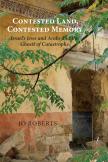Building An ‘Ethnocracy’
When reading Israeli history, one cannot but be affected by the tremendous costs the establishment and survival of the Jewish homeland have exacted from generations of “other” people. The daily headlines about the latest settlement construction or the shooting of unarmed protesters tell us the price it continues to exact from Palestinians. What I had not realized until I read Roberts’s book was the costs it has imposed on “other” Jews, who did not fit the founders’ stereotypes of the strong, assertive “Sabras” (literally “cacti”) who were the heroes of the founding generation.
Jews from Arab lands, for example, known as Mizrahi, were not just the victims of discrimination. They were brutally treated, stripped of their own Arab Jewish culture and aggressively indoctrinated into secular nationalist values. Men’s earlocks were shaved, and they were forced to work on the Sabbath. One Knesset member protested that the treatment of Middle Eastern and North African Jews was nothing less than “the cultural and religious murder of the tribes of Israel.”
The cruelty of nation building crashes in on the reader when Roberts writes that the degradation of Arab Jewish immigrants was inflicted only after bombings—allegedly, and sometimes admittedly, perpetrated by Israeli agents—had driven them to emigrate to Israel out of fear of persecution by their Muslim neighbors.
The founders aspired, as Time magazine prophetically warned in 1948, to form a “little Spartan state.” A garrison state, Sparta had its helots (a subject slave population). Israel has the Palestinians, the Lebanese, rounds of immigrant workers who will be deported before they can make Israel their home and even those Jews whom the Jewish National Agency regarded as “inferior ‘human material.’”
In the early years not even Holocaust survivors were welcome. One Sabra historian describes the psychology of the time. “To put it bluntly, there were almost two races in this country. . . . And there was, we can certainly say, an inferior race. People we saw as inferior who had some kind of flaw, some kind of hunchback, and these were the people who came after the war”—the Holocaust survivors.
One Polish survivor, who in hiding had been both hosted and cheated by a Christian family, found herself isolated and abandoned in Israel. An Israeli psychologist recounted her experience. Her arrival in Israel “was a catastrophe. She was totally ostracized and she did not know what was going on, no one was interested in what she had to say. She said really it was a much worse experience than what she had experienced in Warsaw during the war.”
As I read these accounts on top of stories about the relentless Israeli expulsion and deprivation of Palestinian Arabs, an image from Peter L. Berger’s studies of national development arrested my imagination: the Pyramids of Sacrifice, the Mexican pyramids where humans were killed and dismembered in order to preserve Aztec and other Mesoamerican societies. “Social suffering stems so often,” writes Roberts, “from one group’s need to demonize another in creation of its own identity.”
The pyramid of sacrifice is not the primary message of Jo Roberts’s splendid new study. But it is an image I just could not shake after reading her account of the New Israelis, the early citizens of the Zionist state. One virtue of her book is certainly that she shares so many first-hand accounts and unfiltered reports by participant observers of the decades-long struggle between Israelis and Palestinians that the reader feels extraordinarily in touch with the people and their times.
Again and again, I found myself moved by Roberts’s interviews. The first-hand accounts make the book compelling reading and infuse its arguments with unassailable authenticity. Even for a knowledgeable amateur like myself, who has read numerous histories of Israel’s founding, Roberts illuminates well-known narratives with fresh light.
I read as if for the first time the story of the doomed refugee ship The Exodus and the history of Plan D (Dalat), David Ben Gurion’s strategy for the expulsion of Palestinians from their cities and villages before and after independence.
At the same time, Roberts’s formal arguments have a lapidary quality that makes them appear nearly self-evident. I thought more than once, “I knew that. She’s got that just right, and I couldn’t say it better.”
On the tragic link between trauma and repression, she writes, “A traumatized people is a people frozen by the absolute imperative of ‘Never again!’ for whom security, and the control it necessitates, is imperative.”
Again, she explains why ethnic identity precludes empathy for the other. “The wounds of the past loom in collective memory, obscuring the suffering of others: the land is a safe haven for Jews, not the site of Palestinian catastrophe.”
By Roberts’s account, Israel is not the outcome of the Holocaust; that was a later justification. Neither was it an effort to build a society on biblical values in the historic land of the Jews, as Judah Magnes and Martin Buber had hoped. It is a nation-state, built on the model of militant, 19th century ethnically based nationalism.
Assimilation in European society had proved a failure for Jews. The Dreyfus Affair demonstrated to the early Zionists that for both Christian and secular Europeans Jews were an alien people. “It has been established,” Theodor Herzl wrote, “that justice could be refused to a Jew just because he was a Jew.”
Without a long history as a nation-state, with religion rejected as a burden of the persecuted Jewish past, in the absence of a set of ideas like those in the U.S. founding documents, how did the first Israelis establish a national identity?
The answer was to construct a new collective memory as what Menachem Begin called the fighting Jew. To this day, new recruits in the Israeli Defense Force travel to Masada, the site of the last defiant stand of Jewish rebels against the Roman legions in 73 B.C., to pledge, “Masada shall not fall again.”
Though we, as Americans, are told Israel is “the only democracy in the Middle East,” the political geographer Oren Yiftachel told Roberts, Israel is “an ethnocracy,” bound by blood ties. “A secured Jewish majority,” comments Roberts, “is perceived as more crucial to Jewish survival than is the equality of all Israeli citizens.” What has held Israelis together, in the place of religion, as the 1948 Time article foresaw, is “fear of the Arabs.”
Unfortunately, the methodical expulsion of Palestinians from their homes did not stop in 1948. For Palestinians, the Nakba, the “catastrophe” of Jewish victory and Palestinian dispossession, is “a continuing process.” Israelis have no sympathy for Palestinian suffering. As the conscience-stricken Israeli soldier S. Yizhar wrote in his post-independence novel Khirbet Khizeh, “Everything for the refugees...our refugees, naturally. Those we were driving out were another matter.... We are the masters now.”
Ram Loevy, a director and screenwriter who produced a cinematic version of Khirbet Khizeh, told Roberts how demonizing the Arabs became essential to the existence of the state. “And the Arabs continued to be our enemies.... ‘What if the Nakba hadn’t meant sending into diaspora hundreds of thousands of people, but they had stayed in Israel?’ That was the question that everybody asked, but not too loudly....”
Bringing the story up to date, Roberts treats other topics, including the so-called new historians’ discovery of “the ethnic cleansing of Palestine,” the work of the Israeli nongovernmental organization Zochrot in memorializing destroyed Palestinian villages and debates over the Palestinian right of return and the “transfer” of Arab Israelis out of the country or even beyond the Jordan.
Because of the Israeli voices she has aired in this intelligent and touching book—like those of Yiftachel, Yizar, the volunteers of Zochrot and new historians like Ilan Pappe, who recognize the role of denial of the Nakba in the prolongation of the conflict—Roberts sees possible hope for reconciliation. She quotes Meron Benvenisti, a former deputy mayor of Jerusalem and, as they say in Yiddish, a Mensch (“real human being”): “Maybe we will come to understand that the Other is not demonic, that he, too, is part of this place. Like the cypresses. Like these butansim. These fruit gardens. What the land brings forth.” May it be so.
This article also appeared in print, under the headline “Building An ‘Ethnocracy’,” in the September 29, 2014, issue.








